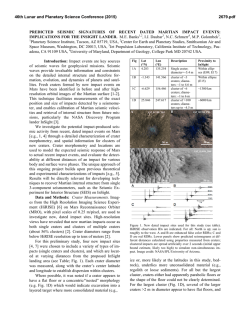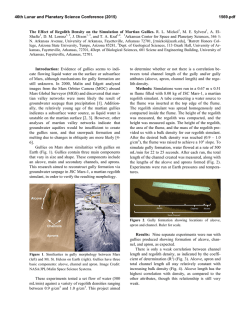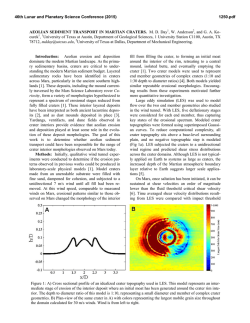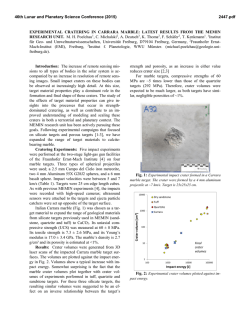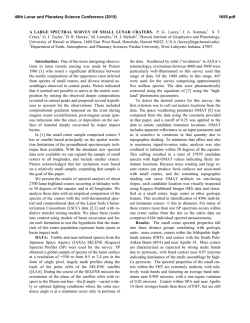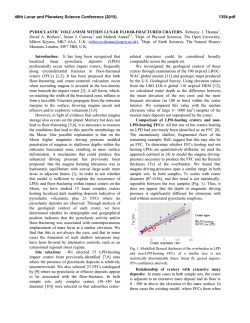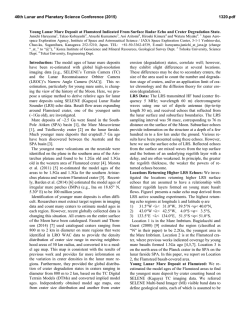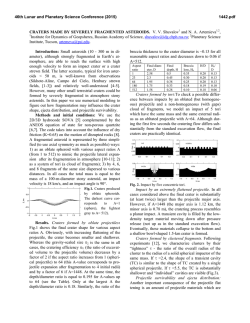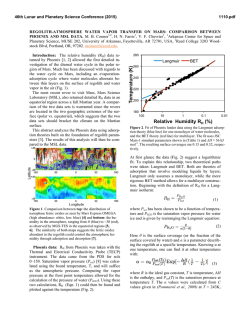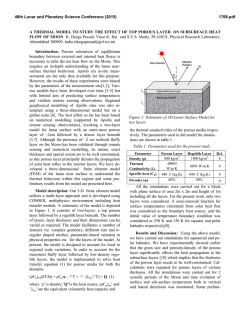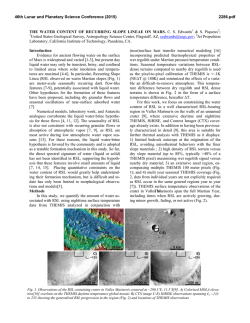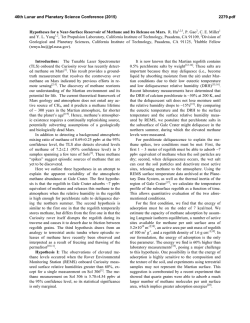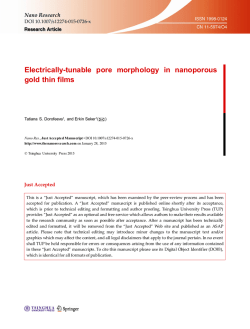
Rules for Regolith Thickness Estimation Using Crater Morphology
46th Lunar and Planetary Science Conference (2015) 1253.pdf RULES FOR REGOLITH THICKNESS ESTIMATION USING CRATER MORPHOLOGY AND ITS APPLICATION TO OCEANUS PROCELLARUM. Tiantian Liu1, Wenzhe Fa1, and Meng-Hua Zhu2, 1Institute of Remote Sensing and Geographical Information System, Peking University, Beijing 100871, China (ttliu@pku. edu.cn, [email protected]), 2Space Science Institute, Macau University of Science and Technology, Macau, China. Introduction: Laboratory impact experiments showed that morphologies of small fresh craters (normal, flat-bottomed, and concentric) depend primarily on regolith thickness [1], and this relation was previously used to estimate lunar regolith thickness over local regions using Lunar Orbiter (LO) photographs [1, 2]. With the release of high-resolution optical images from recent lunar missions (e.g., Lunar Reconnaissance Orbiter, Chang’E-2, Kaguya) [3-5], this method was revived and applied for regolith thickness estimation over larger regions [6, 7]. Nevertheless, previous rules for crater morphology identification are mainly based on LO photographs, and it is not sure whether these rules can be applied directly to recent images that were obtained at different imaging conditions (e.g., illumination angle and spatial resolution). In addition, morphologies of small craters over the lunar surface are very complicated because of target property and degradation [8]. For example, a degraded concentric crater may exhibit a shadow pattern that looks like that of a flat-bottomed one. All these issues might result in serious problems in the estimated regolith thickness. So far as we know, there is no systematical summarization on rules about optical images selection and crater morphology identification. In this study, rules for regolith thickness estimation using crater morphology are summarized by comparing the results from LO photographs and Lunar Reconnaissance Orbiter Camera (LROC) Narrow Angle Cameras (NACs) images. Based on these rules, regolith thickness over Oceanus Procellarum is estimated using LROC NAC images. The estimated regolith thickness is helpful for landing site selection for China’s future lunar sample return missions. Rules: When crater morphology method was first proposed, regolith thicknesses over 12 sites were estimated using LO photographs, and it was found that each site has one of four thickness types with median values of 3.3, 4.6, 7.5 and 16 m [2]. These four regolith thickness distribution types were consistent with a later Monte Carlo simulation of regolith thickness distribution [9], indicating that crater morphology method and the estimated thickness at these sites are reliable. In this study, these 12 sites were taken as the calibration sites for regolith thickness estimation. Crater selection: By replicating regolith thicknesses over these regions using both LO photographs and LROC NAC images [2], two basic rules were found for crater morphology identification. Firstly, only small craters with diameters less than ~250 m can be used for regolith thickness estimation [1]. Small craters display various but distinct morphologies with respect to their sizes [1]. With increasing crater diameter, normal, flat-bottomed, and concentric morphologies appear in sequence. As crater diameter continues to increase, a larger crater will turn into normal again, and the formation mechanism will be different. Secondly, to identify the morphology of a small crater unambiguously, the selected craters should be fresh. A fresh crater suffers less later surface modification since its formation, and as a result, its original morphology can be well preserved. A crater with sharp feature, uplifted rim, and a small number of superposed craters can be regarded as fresh. Crater morphology identification: Identification of crater morphology is the key point of this method. Crater morphology is identified visually according to its shape and shadow pattern. A normal crater has a bowl or conical shape with a single arcuate shadow pattern. A flat-bottomed crater has a pronounced flattened floor as deduced from a single annular shadow pattern. A concentric crater, characterized by a smaller central crater, can be easily evidenced by a double annular or ring-shaped arcuate shadow pattern. In addition, relative size, rim characteristic, and block distribution of small craters can be helpful in distinguishing the type of crater morphology. Normal craters with welldeveloped rims are usually smaller than a few tens of meters [7], and there are no visible blocks on the rims. Craters with flat-bottomed geometry have relatively larger diameters and prominent rims, and there are few or no blocks on the rims. It should be noted that flat floors of smaller craters are usually smooth, nevertheless, floors of larger craters may be hummocky and cracks might occur. The diameter of concentric craters ranges from ten to more than two hundred meters, and there are obvious blocks on their low rims that appear as the ejecta apron. Optical image selection: When high-resolution optical images are used, illumination angle and spatial resolution of the selected images are two important factors that can affect crater morphology identification. The higher the spatial resolution of the image, the smaller the crater whose morphology can be identified. Therefore, if other conditions are the same, an image with the highest spatial resolution is preferred. More 46th Lunar and Planetary Science Conference (2015) craters can be identified in an image with a lower illumination angle. Nevertheless, when illumination angle is smaller than the repose angle of regolith, shadow effect will become a serious problem and might result in misrecognition of the crater morphology [1, 7]. On the other hand, if illumination angle is too large (e.g., >55°), an optical image could become blurry and less craters will be identified. Therefore, images with illumination angles just slightly larger than regolith repose angle are the best choice. In case of illumination angle smaller than the repose angle of regolith, the recognition boundary of crater morphology in regolith thickness calculation should be revised [1, 7]. It should be noted that regolith thickness estimated from concentric craters is usually concordant with that from normal craters. Therefore, we suggest that regolith thickness estimated solely from normal craters is presented [1]. To summarize, Fig. 1 shows the key points for rules in regolith thickness estimation using crater morphology. Regolith Thickness over Oceanus Procellarum: Oceanus Procellarum (20.67°N, 56.68°W, 2592.24 km diameter) is the largest basaltic lava located on the western edge of the lunar nearside [10]. It is divided into 60 spectrally homogeneous units according to the Clementine UVVIS data, and surface ages of these units were estimated using cumulative size-frequency distribution of craters [11]. Based on the rules above, regolith thickness of each unit is estimated using LROC NAC images. In total, 69 images with spatial resolutions from 0.4 to 1.7 m and illumination angles from 21.4° to 52.6° were selected. 51870 small fresh craters with diameter from 3.4 to 154.2 m are counted, of which 32946 are normal and 3204 are concentric. Fig. 2 shows the spatial distribution of the estimated regolith thickness (median value, in italic) and surface age (in roman) for the 60 geologic units. As can be seen, median regolith thickness over Oceanus Procellarum varies from 2.1 to 8.4 m. There are substan- 1253.pdf tial variations in regolith thickness among the 60 geologic units. Several regions (e.g., P57, P60) in Oceanus Procellarum are considered as the youngest surfaces across the Moon, and these regions have a median regolith thickness as small as 2.2 m. Regolith thickness over the northeastern region is larger than that over the southwestern region. When comparing regolith thickness with surface age, it is found that the median regolith thicknesses of the geologic units older than 2.7 Ga are obviously greater than those of the remaining younger units. Nevertheless, the correlation between regolith thickness and surface age is not as strong as expected [7], indicating that regolith evolution over the Procellarum region might be very complex. Conclusions: Rules for regolith thickness estimation using crater morphology are summarized. These rules can be used to estimate regolith thickness over larger region across the Moon using the newly acquired high-resolution optical images from recent missions. As an example, regolith thickness over Oceanus Procellarum and its correlation with surface age are estimated using LROC images. Our results show that median regolith over Oceanus Procellarum varies from 2.1 to 8.4 m, and 45 geologic units (75% of the units) have a regolith thickness smaller than 5.5 m. The estimated results can help for site selection for China’s future lunar sample return missions. References: [1] Quaide W. L. and Oberbeck V. R. (1968) JGR, 73(16), 5247–5270. [2] Oberbeck V. R. and Quaide W. L. (1968) Icarus, 9, 446–465. [3] Haruyama J. et al (2008) EPS, 60(4), 243–255. [4] Zhao B. C. et al. (2011) Sci China Tech Sci, 54(9), 2237–2242. [5] Robinson M. S. et al. (2010) Space Sci. Rev., 150, 81–124. [6] Bart G. D. et al. (2011) Icarus, 215, 485–490. [7] Fa W. et al. (2014) JGR, 119, 1914–1935. [8] Bart G. D. (2014) Icarus, 235, 130–135. [9] Oberbeck V. R. et al. (1973) Icarus, 19, 87–107. [10] Andrew-Hanna J. C. et al. (2014) Nature, 514, 68–71. [11] Hiesinger H. et al. (2003) JGR, 108(E7), 1–27. P1 3.59 7.5 P28: 2.94/3.72 5.7 P28 P55 1.67 3.4 P56 1.49 2.5 P10 3.44 7.0 Crater selection Size: <~250 m 6.6 P58 1.33 P21 3.12 2.93 P29 5.8 5.1 5.7 Freshness: sharp feature, uplifted P9 3.47 2.4 rim, superposed craters P39 2.19 4.5 P37 P53 1.68/3.18 P40 2.14/3.40 7.2 P26 2.96/ 3.49 P31 5.5 P22:3.08 4.2 P30: 2.90 6.1 P37: 2.38/3.56 2.3 2.3 P48 6.1 Morphology identification Rules single arcuate; (2) flat-bottomed: single annular; (3) concentric: ringshaped arcuate or double annular P60 1.20 3.7 3.8 P52 1.73/3.72 3.7 P16 3.33 3.4 P20 3.12/3.93 3.4 P23 P23: 3.07 3.7 P34: 2.592.3 P38: 2.31 2.5 3.4 2.7 P25 2.96/ 3.62 2.41/3.86 P36 Illumination angle repose angle & <~55° 2.7 P24 3.00/3.74 4.4 P44 2.11 P34 3.6 5.1 2.3 P15 3.34/3.87 8.0 P2 3.57 P6 3.48 4.8 P12 3.42 P18 3.32 Image 4.5 P5 3.48 2.5 2.5 rim characteristic, block distribution High is preferred P43 2.12 P51 1.85 P19 3.31 Other information: relative size, Spatial resolution 2.2 P49 2.01 Regolith thickness 8.4 P32 2.76 P14 3.36/3.62 P22 Shadow pattern: (1) normal: P7 3.48 P4 P30 conical; (2) flat-bottomed: flattened floor; (3) concentric: crater-in-crater P4: 3.48/3.74 6.3 P31: 2.88/3.72 5.4 P48: 2.04 6.2 P59: 1.21 4.8 P59 5.3 Geometry: (1) normal: bowl or Crater P13 3.40 P57 1.33 2.2 P33 2.59/ 3.63 P41 2.13 P47 2.08 P50 1.87 5.3 4.0 2.1 P35 2.54 P45 2.09/3.70 3.1 2.3 2.8 P11 3.43 4.0 P3 3.53 P8 3.47 7.0 P46 2.08 4.6 P27 2.96 4.3 P38 3.0 < repose angle Revise recognition boundary Figure 1. Flow chart showing the rules for regolith thickness estimation using crater morphology. P17 3.32 P54 1.67 2.3 3.6 P42 2.12 2.8 Figure 2. Estimated regolith thickness (m) based on normal craters over Oceanus Procellarum.
© Copyright 2025

